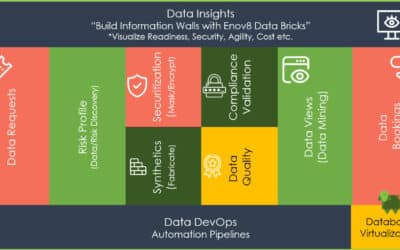
What are the different types of release management?
OCT, 2023
by Andrew Walker.
Author Andrew Walker
Andrew Walker is a software architect with 10+ years of experience. Andrew is passionate about his craft, and he loves using his skills to design enterprise solutions for Enov8, in the areas of IT Environments, Release & Data Management.
Release management is a critical aspect of IT operations and software development. It ensures that changes, updates, and new features are delivered to end-users efficiently and with minimal disruption. In this article, we’ll explore the different types of release management and their significance in the IT landscape.
Enov8 Enterprise Release Manager
*Innovate with Enov8
Streamline delivery of IT change through embracing “Scaled Agile” best practice.
Release management becomes even more essential in today’s fast-paced and agile-driven environments. To streamline the delivery of IT changes and embrace “Scaled Agile” best practices, organizations often turn to specialized tools like Enov8 Enterprise Release Manager.
Understanding Release Management
Release management serves as the cornerstone of IT operations and software development, playing a pivotal role in ensuring that changes, updates, and new features are introduced into IT systems and services effectively and efficiently. It is a structured and strategic approach that encompasses the planning, coordination, and execution of these changes, all while maintaining the stability, reliability, and overall integrity of the systems in question.
Release management operates at the intersection of IT service management and software development lifecycles. It acts as a bridge between development teams that create new code or features and operations teams responsible for maintaining and delivering these changes to end-users.
This process involves meticulous planning, comprehensive testing, and careful coordination to minimize disruptions to the organization’s operations. By implementing effective release management practices, organizations can not only ensure the successful delivery of changes but also enhance the overall quality of their IT services and systems.
In essence, release management is a strategic discipline that aligns IT activities with the goals and objectives of the business. It provides a structured framework for controlling, tracking, and auditing changes to IT systems, ensuring that they align with organizational requirements and regulatory standards.
In the subsequent sections of this article, we will delve deeper into the different types of release management, including Emergency, Major, and Minor releases, and how organizations can tailor their approaches to meet specific needs, all while leveraging tools like Enov8 Enterprise Release Manager to streamline and optimize the process.
Types of Release Management
Release management encompasses various types, each tailored to specific scenarios and requirements within IT operations and software development. These release types dictate how changes are planned, executed, and delivered to end-users, with distinct characteristics and purposes.
Emergency Releases
Emergency releases represent a critical facet of release management. These releases are deployed urgently to address severe and unforeseen issues that have the potential to disrupt an organization’s operations or services. They are typically unplanned and may necessitate expedited processes to mitigate the impact of the issue at hand.
Key Points:
Swift response to critical issues.
Real-time tracking and management.
Major Releases
Major releases represent another critical category within release management, specifically designed to handle substantial changes and enhancements to IT systems and services. These releases are meticulously planned and orchestrated, as they often entail the introduction of new features, substantial updates, or architectural changes that can profoundly influence the organization’s operations and strategies.
Key Characteristics and Considerations:
1. Meticulous Planning and Coordination: Major releases demand meticulous planning and coordination to ensure a seamless transition. This involves careful consideration of timelines, resource allocation, and risk assessment. Steering committees, comprised of senior executives and leaders, often play a pivotal role in making informed decisions and providing strategic direction during the planning and execution phases.
2. Significance of Structured Frameworks: The significance of structured frameworks cannot be overstated when dealing with major releases. These frameworks provide a systematic approach to managing the complexity of the changes involved. One such framework that is gaining popularity is the Scaled Agile Framework (SAFe), which offers a well-defined structure for orchestrating major releases. Tools like Enov8 Enterprise Release Manager can seamlessly integrate with SAFe, aiding in the definition of release trains, program increment planning, and efficient project and work item tracking.
Major releases are not just technical updates; they are strategic endeavors that can shape an organization’s competitive edge and future direction. Therefore, meticulous planning, adherence to structured frameworks, and the engagement of key stakeholders are paramount to the successful execution of major releases.
Minor Releases
Minor releases play a vital role in maintaining the health and functionality of IT environments. While they may not grab headlines like major releases, their significance should not be underestimated. Minor releases focus on implementing smaller-scale updates, routine maintenance, and addressing minor issues within IT systems and services.
Key Points:
Routine maintenance and bug fixes.
Incremental improvements and small feature additions.
Contribution to system stability and reliability.
Customization and Workflows
One of the standout features of Enov8 Enterprise Release Manager is its exceptional flexibility, which empowers organizations to tailor their release management workflows precisely to align with their unique needs and processes. This adaptability is instrumental in optimizing the release management process, enabling organizations to operate seamlessly, whether they adhere to Scaled Agile Framework (SAFe) principles or have devised a customized approach.
Customizing Release Workflows: Enov8 Enterprise Release Manager empowers organizations to create, modify, or fine-tune release workflows, ensuring they align precisely with the organization’s specific requirements. Whether your organization follows SAFe practices, Agile methodologies, or has developed its own release management framework, this tool is designed to adapt and accommodate your distinct processes.
Tailored to Your Needs: The tool allows for the creation of custom phases, tasks, and approval processes. This means you can define workflows that match your organization’s unique project requirements. Whether it’s the sequence of activities, the roles and responsibilities of team members, or the specific criteria for approvals, Enov8 Enterprise Release Manager provides the flexibility needed for precise customization.
Alignment with SAFe Principles: For organizations embracing SAFe principles, this tool seamlessly integrates with the SAFe framework. It facilitates Release Train Definition, Program Increment Planning, Product (System) Identification, Project Team Registration, Project & Work Item Tracking, Environment & System Contention Management, Implementation Planning, Post Implementation Reviews, and Event Deployment Tracking, all in harmony with SAFe principles.
The Role of Release Management Tools
Release management tools, such as Enov8 Enterprise Release Manager, play a pivotal role in automating and streamlining the release process. This cloud-native platform offers a comprehensive suite of capabilities that extend from the inception of a release through its execution and evaluation. It is especially well-suited for organizations seeking to adopt SAFe practices, enabling them to centralize governance and optimize their release and deployment processes efficiently.
Automation and Streamlining: These tools eliminate manual, error-prone processes, and facilitate automation in release planning, coordination, and execution. This results in greater efficiency, reduced human error, and faster time-to-market.
Comprehensive Capabilities: Enov8 Enterprise Release Manager encompasses a wide array of functionalities, including Release Train Definition, Program Increment Planning, Product (System) Identification, Project Team Registration, Project & Work Item Tracking, Environment & System Contention Management, Implementation Planning, Post Implementation Reviews, and Event Deployment Tracking. This comprehensive suite covers every aspect of the release process, ensuring a holistic approach to release management.
Adherence to SAFe Practices: For organizations that have adopted or are considering SAFe practices, this tool serves as an ideal companion. It is designed to seamlessly align with SAFe principles, offering a structured framework for SAFe implementation and governance.
Best Practices in Release Management
Effective release management hinges on the adoption of industry best practices. Release management tools like Enov8 Enterprise Release Manager further enhance these practices by providing a unified platform for collaboration, planning, tracking, and reporting, streamlining the entire release process.
Collaboration and Communication: Enov8 Enterprise Release Manager facilitates collaboration among cross-functional teams involved in the release process. It promotes communication and information sharing, fostering a cohesive and well-informed release team.
Planning and Tracking: The tool simplifies release planning and tracking. It enables teams to define clear objectives, allocate tasks, set timelines, and monitor progress in real-time. This level of transparency is invaluable in keeping the release on track and ensuring all stakeholders are aware of the current status.
Reporting and Analytics: By offering robust reporting and analytics capabilities, Enov8 Enterprise Release Manager allows organizations to gain insights into release performance. This data-driven approach enables organizations to identify bottlenecks, areas for improvement, and areas of success, driving continuous improvement in release management practices.
In conclusion, the integration of tools like Enov8 Enterprise Release Manager elevates release management to a more efficient and effective level. By fostering customization, alignment with industry best practices, and adherence to frameworks like SAFe, it empowers organizations to master the art of release management while delivering high-quality IT changes to their users.
Conclusion
In summary, release management stands as the cornerstone of IT operations and software development, orchestrating the seamless deployment of crucial IT changes. Within this intricate landscape, the Enov8 Enterprise Release Manager tool emerges as an indispensable asset. It operates on the solid foundation of the Scaled Agile Framework, providing organizations with a robust platform to centrally oversee and orchestrate all enterprise releases and deployments.
By harnessing the capabilities of Enov8 Enterprise Release Manager and delving into the nuances of the various release types, organizations can transcend the challenges of modern IT landscapes. They gain the power to optimize their IT change delivery processes, ensuring the agility and resilience necessary to compete effectively in the rapidly evolving digital terrain.
Through customization, alignment with best practices, and the adoption of efficient release management tools like Enov8, organizations can not only navigate the complexities of release management but also elevate their ability to deliver high-quality IT changes promptly and confidently. This empowers them to remain agile and responsive in an era where adaptability and innovation are the keys to sustainable success.
Relevant Articles
8 DevOps Anti-Patterns to Avoid
It’s the normal case with software buzzwords that people focus so much on what something is that they forget what it is not. DevOps is no exception. To truly embrace DevOps and cherish what it is, it’s important to comprehend what it isn’t. A plethora...
An Introduction to Application Rationalization
In today's fast-paced digital landscape, organizations often find themselves grappling with a sprawling array of applications. While these applications are crucial for various business operations, the lack of a structured approach to managing them can lead to...
What Makes a Great Test Data Management Tool
What Makes a Great Test Data Management Tool? In today's fast-paced IT landscape, having a robust Test Data Management (TDM) tool is crucial for ensuring quality, compliance, and efficiency in software development and testing. At Enov8, we pride ourselves on providing...
The Top Application Portfolio Management Tools
Managing an application portfolio is essential for organizations aiming to optimize their IT operations, reduce costs, and enhance overall efficiency. Application Portfolio Management (APM) tools are designed to help organizations achieve these goals by providing a...
What Is a Test Data Manager?
Testing is a critical aspect of software development, and it requires the use of appropriate test data to ensure that the software performs optimally. Test data management (TDM) is the process of creating, storing, and managing test data to ensure its quality,...
Sprint Scheduling: A Guide to Your Agile Calendar
Agile sprints can be a powerful, productive and collaborative event if managed properly. However, when neglected or set up incorrectly they risk becoming chaotic and inefficient. Crafting an effective schedule for your sprint is essential to ensure the success of your...










